Oxy-fuel processes: it’s everyone’s responsibility
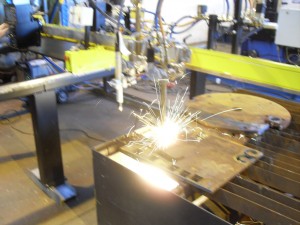
Our Insurance company carried out an inspection to ensure we were carrying out safe practice, quite normal for our industry considering the dangers.
My attention was drawn to the conditions imposed for the use of heat away from our premises. Lengthy discussions followed with our Technical Director, Mark Reaney, to ensure we all understood the cover and how we could protect our employees and the company during these procedures.

Here Paul Woodford of ESAB, leading welding equipment manufacturers provides guidelines for proper set-up and shutdown procedures, as well as technical and safety principles.
Please share his knowledge and advice with your employees to ensure you too have safe practice.
Despite these hazards, millions of people work accident free. By design, manufacturers build safe equipment. This decreases the likelihood of a potential incident.
However, good oxy-fuel operators know that their own safety, as well as the safety of those around them, depends on proper and responsible use of oxy-fuel equipment.
Fire triangle
The foundation for all oxy-fuel processes is the Triangle of Combustion or Fire Triangle. Combustion requires three elements: fuel, oxygen and heat. Operators must control each of these elements, which is why safety starts with a clean work area free from oily rags, paper, volatile liquids, trashcans and other combustibles. It should go without saying that there’s no smoking, but it needs to be reinforced.
Oxy-fuel processes produce flames, sparks and a small amount of infrared rays. Eye protection options include a face shield, goggles or safety glasses, all with the appropriate shade lens. If operators use a face shield, they must also wear safety glasses underneath.
It is strongly recommended that operators use fire-retardant overalls and safety boots for all these processes.
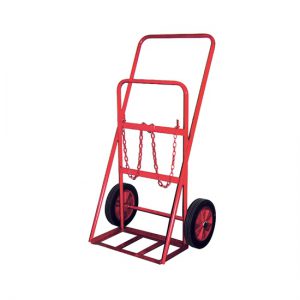
Cylinder Identification and Handling
The cylinder shoulder marking has now been standardised under EN 1089-3 to help improve safety with industrial gases. The standard colours are applied to the shoulder or curved part at the top of the cylinder. The common gases and colours are:
- Oxygen – White shoulder
- Acetylene – Maroon shoulder
- Flammable Gases – Red
- Inert Gases – Bright Green
- Nitrogen – Black
- CO2 – Grey
- Helium – Brown
The cylinder body colour may vary between different gas companies. Also types of paint, wear and industrial service may modify the cylinder body colour so it is important to check the labels. The label is the primary means of identifying the gas and its properties.
All cylinders have a United Nations (UN) gas identification marking on their label. Common ID numbers include UN 1072 for oxygen, UN 1001 for acetylene, UN 1978 for propane and UN 1077 for propylene.
Careless handling can turn a gas cylinder into a projectile. Whenever operators handle a cylinder, they should keep these five fundamentals in mind:
- * Before moving a cylinder, install the cylinder cap, if there is one
- * Use a cylinder trolley designed to transport cylinders
- * Place cylinders in a safe location where they’re protected from sparks, flames and heat sources. Don’t block equipment or people
- * Once in place, secure the cylinders in an upright position to prevent falling
Lastly, inspect the valve. Look for signs of damage, and always ensure the valve is free from oil and grease.
Gases in the work area
Many workshops have multiple gases on site, and each gas has its own safety precautions. To start, recall that oxygen is one of the components for the Triangle of Combustion.
In fact, oxygen is the source for many gas-related accidents, and a primary culprit is using oxygen in place of compressed air. Some of the areas oxygen gets misused include using it to blow dust off clothing or work areas, with pneumatic tools or as ventilation in the place of air.
The most widely used fuel gas is acetylene. Other fuels are commonly referred to as ‘alternate fuels’. These include LP gases (propane, propylene and butane) and compressed gases such as natural gas and methane.
The basic structure of an acetylene cylinder is different from other cylinders (which are shells only) because it contains a porous mass saturated with liquid acetone. The acetylene gas is then pumped into the cylinder, absorbed into the acetone and released as it is used. Because of its nature, always use and store the acetylene cylinder in an upright position, and never use acetylene above 1.5 bar
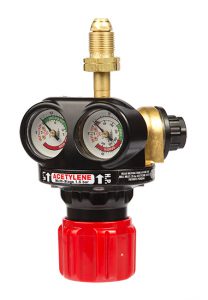
Equipment set-up: regulators
Because different gases have different volume and pressure requirements, manufacturers engineer regulators for specific gases.
ESAB EDGE regulators are colour-coded and labelled for easy identification: Blue for oxygen, red for acetylene, orange for gases such as propane and propylene, grey for carbon dioxide, black for inert gases such as argon and nitrogen. In some cases these colours differ by European geography, if in doubt contact your local gas supplier.
Pure oxygen can reduce the ignition temperature of petroleum-based lubricants to room temperature, leading to violent combustion. As such, the first safety check is to inspect regulator valves, threads and seats and ensure they are free of oil. Needless to say, never lubricate any component of an oxy-fuel system. Parts contaminated with oil or grease should be inspected and cleaned by qualified service personnel.
Next, inspect regulator and cylinder fittings, making sure they’re free of damage and dirt. Note: if the nut on the regulator does not match the fitting on the cylinder, it means the wrong regulator has been selected. Find the correct one; never change the fittings on a regulator.
Before attaching a regulator, it is necessary to clear the valve assembly of contaminants and combustibles. Normal practice used to be to ‘snift’ the valve, ie stand to the side of the cylinder, point the valve toward a clear area, crack the valve and close it again.(not hydrogen).
However, modern safety practice recommends that the valve be carefully wiped clean with a dry, lint free cloth. After doing this for both cylinders, the operator is ready to attach the regulators.
Equipment set-up: hoses
The acetylene hose, which is typically red, has a groove across the nut, which indicates a left-hand thread. The oxygen hose, which is typically blue, will not have a groove, indicating that it’s a right-hand thread. Before attaching the hose, inspect it for oil, grease and cracks.
After attaching, remove potential contaminants by purging the hose. Contamination, if not removed, could be forced into the equipment and potentially cause clogging, failure or provide a source of combustion. To purge a hose, adjust the regulator knob to about .5 Bar and allow gas to flow for a few seconds.
Depending on the length of hose, that time may vary. Back out the adjusting knob after allowing adequate flow and repeat the process for the other hose.
Note: Only open the acetylene cylinder valve 3/4 to one full turn; this facilitates faster shut-off in the event of an emergency. Open oxygen cylinders all the way, as their valves seal in the fully open and fully closed positions.
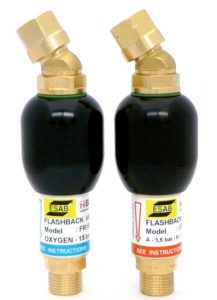
Understanding hazards
To fully understand torch safety, operators must understand some of the terms for the hazards associated with oxy-fuel equipment. The terms are: reverse flow, flashback, backfire and sustained backfire.
Reverse flow is when either the oxygen enters the fuel gas side of a system or the fuel gas enters the oxygen side of the system. This occurs when there is a restriction of one of the gases or an imbalance of pressure. This can be caused by a clogged or blocked tip or allowing one of the cylinders to run out of gas. If a reverse flow condition exists, a flashback can occur.
Flashback is the return of a flame through the torch, into the hose and even into the regulator. It could potentially reach the cylinder. This condition could cause an explosion anywhere within the system. Flashback arrestors are designed to prevent the flame from traveling beyond the point of the arrestor. Flashback arrestors contain a sintered filter that prevents a flame from passing through the filter element.
Backfire is the return of a flame back into the torch, which produces a popping sound. The flame will either extinguish or reignite at the tip. This is normally the result of accidentally bumping the tip against the work piece, operating the tip too close to the work piece or allowing the tip to become over-heated. A sustained backfire is when a backfire occurs and continues burning in the torch. This condition may be accompanied by a popping sound followed by a continuous whistling or hissing sound.
Some of the causes for this are improperly maintained equipment, overheating of the equipment or improper pressure settings for the equipment being used.
Torch inspection and gas flow
Most torches come in two sections, the torch handle and various attachments for heating, cutting and welding. Before using an attachment, check its cone end and be sure the two O-rings are neither missing nor damaged. Repair them or replace them if necessary. On a cutting attachment, check the seating end for the tip. Dents or scratches here could lead to a leak and promote an accident.
Before connecting any attachment to the torch, inspect the seating area of the torch handle and the thread assembly. When attaching them, hand-tighten only. Using a wrench will damage the O-rings.
Next, inspect the cutting or heating tip to ensure the holes are free of debris. On a cutting tip, check the seating end for scratches or dents. To properly secure a cutting tip, which is a metal-to-metal seal, tighten it with a wrench. Before cutting, make sure the cutting oxygen lever moves freely.
When setting gas pressures always refer to the manufacturer’s recommendations. The thickness of plate being heated or cut determines what consumable to use, and that, in turn, determines pressure settings. This information is normally found in the manufacturer’s operating procedures or in tip charts. Note that alternate fuels use different tips and require different pressure settings.
Leak test
After connecting the attachments and tips, operators need to check the entire system for leaks.
The steps to perform a leak test are as follows:
* Completely back out the regulator adjusting mechanism
* Open the cylinder gas valve slowly until the high pressure gauge reading stabilizes, then shut off the cylinder valve. Monitor the gauge for any pressure drop, which would indicate a leak of the high pressure side of the system. If no leak is evident, open the cylinder valve and adjust the oxygen regulator to deliver 1.4bar (20 PSI)
* Repeat the process with the fuel gas valve and regulator, but be sure to adjust the fuel gas regulator to deliver about 0.7 bar (10 PSI)
* Close both the oxygen and fuel cylinder valves
* Turn the adjusting screw or knob counter-clockwise one-half turn
* Observe the gauges on both regulators for a few minutes. If the gauge readings do not change, then the system is leak tight
* Open the cylinder valves again. Any movement of the needles indicates a possible leak
* If a leak is observed, stop. Do not use leaking equipment. Check all the connections. If the leak can’t be found, have the equipment inspected by a qualified technician.
Purging the torch
Torches also need to be purged to eliminate the possibility of gases mixing prematurely, which could lead to a flashback, or worse.
To start, open the oxygen valve on the torch handle all the way. With a cutting attachment, also open the preheat oxygen valve. Depress the cutting lever for 3 to 5 seconds. Shut the oxygen valves and repeat the process for the fuel side. This is also a good time to recheck the regulators to make sure they maintained set pressure.
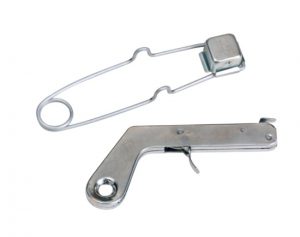
Lighting the torch and adjusting the flame
For an acetylene heating or cutting attachment, hold the torch in one hand and a spark lighter in the other (never use matches or a lighter to light the torch). Do not aim the torch in a direction of people, equipment or flammable materials.
Open the fuel valve about 1/8th of a turn and ignite the gas. Continue opening the fuel valve until all the smoke and soot disappear. Transfer over to the oxygen valve and slowly open it until a bright neutral flame is established. Note: Some blowpipes notably injector designs require that the oxygen is opened first to draw through the fuel gas. Always follow the manufacturer’s instructions.
Alternate fuels have a specific gravity, either much heavier (propane and propylene) or much lighter (natural gas) than air. As a result, operators should always refer to the manufacturers recommendations before lighting up the torch.
Shutdown
When using an equal pressure torch it is always recommended to shut down the fuel gas first followed by the oxygen
To shut down the entire system, start by closing both cylinder valves. Next, release the pressure inside the system by opening the oxygen valve on the torch until pressure decays; do the same with the fuel gas valve. Next, release the tension on the regulator by turning the knob or screws counterclockwise until they move freely. Check the regulators to be sure that they indicate zero pressure in the system.
Always follow the proper shutdown procedures when finished cutting, even if it’s just for a lunch break. Never leave oxy-fuel systems pressurised while unattended. A leaking torch or hose could cause a pool of gas to build up (such as inside a barrel), creating a serious hazard.
Leader, participant guidelines
By following these guidelines, operators minimise the possibility of an accident and make the environment safe for those around them.
To support training efforts, ESAB offers a DVD featuring a 36-minute Oxy-Fuel Safety Video in English or Spanish and extensive supplemental documents. These documents include checklists for many of the best practices discussed in this article, a 65-page Leader’s Guide on how to conduct a successful seminar and a Participant’s Guide with training materials and quizzes to assess knowledge absorption.
Paul Woodford is Global Product Manager, ESAB. This article was written for EngineerLive
Probably you and your employees have had a great record when it comes to safety? But these days in such a claim dominated culture, the advice is to check regularly your practices and document all your risk assessments both on and off site.
If you enjoyed reading this article, you can find more Safety solutions on ESAB’s web site or you can find out more about an ESAB Gas Inspectors Course here
Westermans International Ltd are supplies and buyers of new and used Welding and Cutting equipment which includes plasma cutting systems and welding fume extractors.
For all our ESAB related products for sale today please click here
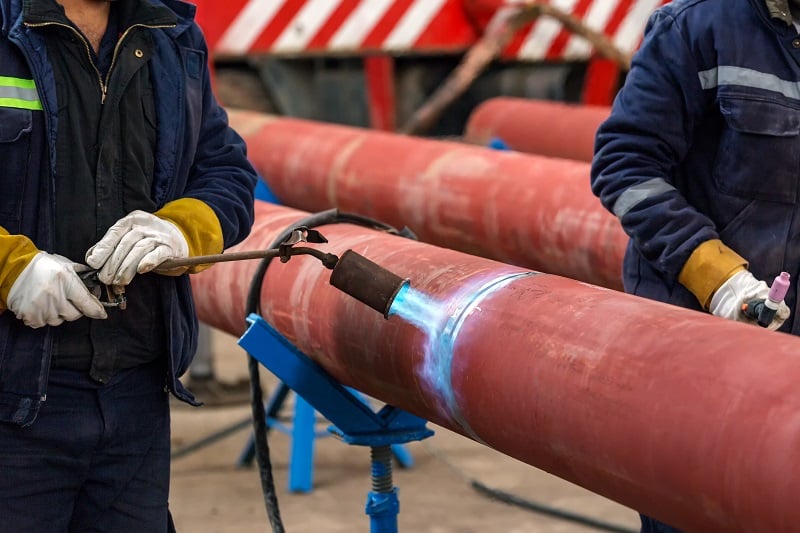

comments
Good collection of information